Effect of Spatter Behavior on Mechanical Properties and Surface Roughness of Printed Parts during PBF-LM of 316L
Abstract
1. Introduction
2. Experiment Scheme
2.1. Experimental Equipment
2.2. Experimental Methods
2.3. Spatter Images Processing Methods
3. Results and Discussion
3.1. Analysis of Spatter Results
3.2. Mechanical Property Analysis of Printed Samples
3.3. Microstructure Analysis of Printed Samples
3.4. Samples Surface Roughness Analysis
4. Conclusions
- During PBF-LM, more spatters are created as the laser power increases, and more spatters are generated at high laser power and high powder layer thickness than at low laser power and low powder layer thickness. Moreover, in the case of LSD-W, the protective gas cannot blow away the generated dust in time, resulting in the laser beam having to pass through the dust before acting on the pre-printing area, which leads to unstable laser energy input and disrupts the uniformity of the molten pool flow, resulting in more spatters generated. Therefore, under the same laser power, LSD-A produces less spatters than LSD-W.
- From the tensile test results of the printed tensile samples, the tensile strength and elongation of the samples printed under the process of 0.05 mm powder layer thickness and 320 W laser power are the best in the whole experimental group, but the most spatters are produced by this process. According to the microstructure comparison of the printed pattern, the more equiaxed cellular structure produced in the molten pool under this process is different from the more columnar grains produced in other processes, which can effectively improve the mechanical properties of the printed parts. The method of epitaxial growth of grains along the border of the molten pool is also more conducive to improving the mechanical properties of printed parts. Therefore, the difference in the number of spatters generated by the PBF-LM process under different process parameters is not the key factor affecting the mechanical properties of printed parts. Still, the difference in microstructure of printed parts under different processes is the main factor affecting the mechanical properties.
- According to the surface roughness test results under various conditions, the quantity of spatters and the surface roughness value of printed samples rise as laser power rises. Spatter behavior is the primary factor impacting the surface quality of parts, and it has a direct relationship with the surface quality of PBF-LM printed parts.
- Due to differences in spatters generated under different process parameters in the PBF-LM process, it is not the determining factor affecting the difference in tensile strength of printed parts. Spatter generation has a more direct impact on the surface roughness of printed parts; therefore, the process parameters can be adjusted according to the performance requirements of different printing targets. For example, when there are higher requirements for the surface quality of printed parts, low powder layer thickness and low laser power can be used to cooperate with printing. The spatters generated during the printing process are less, and excellent surface quality can be achieved. On the contrary, if there is no high requirement for the surface quality of printed parts, high laser power and high powder layer thickness can be used for coordinated printing, resulting in faster printing speed and improved production efficiency.
Supplementary Materials
Author Contributions
Funding
Institutional Review Board Statement
Informed Consent Statement
Data Availability Statement
Conflicts of Interest
References
- Yap, C.Y.; Chua, C.K.; Dong, Z.L.; Liu, Z.H.; Zhang, D.Q.; Loh, L.E.; Sing, S.L. Review of selective laser melting: Materials and applications. Appl. Phys. Rev. 2015, 2, 041101. [Google Scholar] [CrossRef]
- Kruth, J.-P.; Mercelis, P.; Van Vaerenbergh, J.; Froyen, L.; Rombouts, M. Binding mechanisms in selective laser sintering and selective laser melting. Rapid Prototyp. J. 2005, 11, 26–36. [Google Scholar] [CrossRef]
- Jia, H.; Sun, H.; Wang, H.; Wu, Y.; Wang, H. Scanning strategy in selective laser melting (PBF-LM): A review. Int. J. Adv. Manuf. Technol. 2021, 113, 2413–2435. [Google Scholar] [CrossRef]
- Louvis, E.; Fox, P.; Sutcliffe, C.J. Selective laser melting of aluminium components. J. Am. Acad. Dermatol. 2011, 211, 275–284. [Google Scholar] [CrossRef]
- Strano, G.; Hao, L.; Everson, R.M.; Evans, K.E. Surface roughness analysis, modelling and prediction in selective laser melting. J. Am. Acad. Dermatol. 2013, 213, 589–597. [Google Scholar] [CrossRef]
- Thijs, L.; Verhaeghe, F.; Craeghs, T.; Van Humbeeck, J.; Kruth, J.P. A study of the microstructural evolution during selective laser melting of Ti–6Al–4V. Acta Mater. 2010, 58, 3303–3312. [Google Scholar] [CrossRef]
- Cheng, B.; Shrestha, S.; Chou, K. Stress and deformation evaluations of scanning strategy effect in selective laser melting. Addit. Manuf. 2016, 12, 240–251. [Google Scholar] [CrossRef]
- Sing, S.L.; Yeong, W.Y. Laser powder bed fusion for metal additive manufacturing: Perspectives on recent developments. Virtual Phys. Prototyp. 2020, 15, 359–370. [Google Scholar] [CrossRef]
- Concli, F.; Gilioli, A. Numerical and experimental assessment of the mechanical properties of 3D printed 18-Ni300 steel trabecular structures produced by Selective Laser Melting–a lean design approach. Virtual Phys. Prototyp. 2019, 14, 267–276. [Google Scholar] [CrossRef]
- Zhang, J.; Song, B.; Wei, Q.; Bourell, D.; Shi, Y. A review of selective laser melting of aluminum alloys: Processing, microstructure, property and developing trends. J. Mater. Sci. Technol. 2018, 35, 270–284. [Google Scholar] [CrossRef]
- Wang, Z.; Guan, K.; Gao, M.; Li, X.; Chen, X.; Zeng, X. The microstructure and mechanical properties of deposited-IN718 by selective laser melting. J. Alloys Compd. 2012, 513, 518–523. [Google Scholar] [CrossRef]
- Gusarov, A.V.; Smurov, I. Modeling the interaction of laser radiation with powder bed at selective laser melting. Phys. Procedia 2010, 5, 381–394. [Google Scholar] [CrossRef]
- Sanaei, N.; Fatemi, A.; Phan, N. Defect characteristics and analysis of their variability in metal L-PBF additive manufacturing. Mater. Des. 2019, 182, 108091. [Google Scholar] [CrossRef]
- Sausto, F.; Carrion, P.E.; Shamsaei, N.; Beretta, S. Fatigue failure mechanisms for AlSi10Mg manufactured by L-PBF under axial and torsional loads: The role of defects and residual stresses. Int. J. Fatigue 2022, 162, 106903. [Google Scholar] [CrossRef]
- Elambasseril, J.; Rogers, J.; Wallbrink, C.; Munk, D.; Leary, M.; Qian, M. Laser powder bed fusion additive manufacturing (LPBF-AM): The influence of design features and LPBF variables on surface topography and effect on fatigue properties. Crit. Rev. Solid State Mater. Sci. 2023, 48, 132–168. [Google Scholar] [CrossRef]
- Cabrini, M.; Carrozza, A.; Lorenzi, S.; Pastore, T.; Testa, C.; Manfredi, D.; Fino, P.; Scenini, F. Influence of surface finishing and heat treatments on the corrosion resistance of LPBF-produced Ti-6Al-4V alloy for biomedical applications. J. Mater. Process. Technol. 2022, 308, 117730. [Google Scholar] [CrossRef]
- Sato, Y.; Srisawadi, S.; Tanprayoon, D.; Suga, T.; Ohkubo, T.; Tsukamoto, M. Spatter behavior for 316L stainless steel fabricated by selective laser melting in a vacuum. Opt. Lasers Eng. 2020, 134, 106209. [Google Scholar] [CrossRef]
- Chen, H.; Zhang, Y.; Giam, A.; Yan, W. Experimental and computational study on thermal and fluid behaviours of powder layer during selective laser melting additive manufacturing. Addit. Manuf. 2022, 52, 102645. [Google Scholar] [CrossRef]
- Wang, D.; Wu, S.; Fu, F.; Mai, S.; Yang, Y.; Liu, Y.; Song, C. Mechanisms and characteristics of spatter generation in PBF-LM processing and its effect on the properties. Mater. Des. 2017, 117, 121–130. [Google Scholar] [CrossRef]
- Shuai, L.; Qinghong, J.; Sai, G.; Bi, Z.; Cong, Z. Effect of spattering on formation mechanisms of metal matrix composites in laser powder bed fusion. J. Am. Acad. Dermatol. 2022, 304, 117533. [Google Scholar] [CrossRef]
- Gunenthiram, V.; Peyre, P.; Schneider, M.; Dal, M.; Coste, F.; Koutiri, I.; Fabbro, R. Experimental analysis of spatter generation and melt-pool behavior during the powder bed laser beam melting process. J. Am. Acad. Dermatol. 2018, 251, 376–386. [Google Scholar] [CrossRef]
- Ladewig, A.; Schlick, G.; Fisser, M.; Schulze, V.; Glatzel, U. Influence of the shielding gas flow on the removal of process by-products in the selective laser melting process. Addit. Manuf. 2016, 10, 1–9. [Google Scholar] [CrossRef]
- Anwar, A.B.; Pham, Q.C. Selective laser melting of AlSi10Mg: Effects of scan direction, part placement and inert gas flow velocity on tensile strength. J. Mater. Process. Technol. 2017, 240, 388–396. [Google Scholar] [CrossRef]
- Khairallah, S.A.; Anderson, A.T.; Rubenchik, A.; King, W.E. Laser powder-bed fusion additive manufacturing: Physics of complex melt flow and formation mechanisms of pores, spatter, and denudation zones. Acta Mater. 2016, 108, 36–45. [Google Scholar] [CrossRef]
- Young, Z.A.; Guo, Q.; Parab, N.D.; Zhao, C.; Qu, M.; Escano, L.I.; Fezzaa, K.; Everhart, W.; Sun, T.; Chen, L. Types of spatter and their features and formation mechanisms in laser powder bed fusion additive manufacturing process. Addit. Manuf. 2020, 36, 101438. [Google Scholar] [CrossRef]
- Simonelli, M.; Tuck, C.; Aboulkhair, N.T.; Maskery, I.; Ashcroft, I.; Wildman, R.D.; Hague, R. A study on the laser spatter and the oxidation reactions during selective laser melting of 316L stainless steel, Al-Si10-Mg, and Ti-6Al-4V. Met. Mater. Trans. A 2015, 46, 3842–3851. [Google Scholar] [CrossRef]
- Matthews, M.J.; Guss, G.; Khairallah, S.A.; Rubenchik, A.M.; Depond, P.J.; King, W.E. Denudation of metal powder layers in laser powder-bed fusion processes. In Additive Manufacturing Handbook; CRC Press: Boca Raton, FL, USA, 2017; pp. 677–692. [Google Scholar]
- Tang, M.; Pistorius, P.C. Oxides, porosity and fatigue performance of AlSi10Mg parts produced by selective laser melting. Int. J. Fatigue 2017, 94, 192–201. [Google Scholar] [CrossRef]
- Bidare, P.; Bitharas, I.; Ward, R.M.; Attallah, M.M.; Moore, A.J. Fluid and particle dynamics in laser powder bed fusion. Acta Mater. 2018, 142, 107–120. [Google Scholar] [CrossRef]
- Yin, J.; Wang, D.; Yang, L.; Wei, H.; Dong, P.; Ke, L.; Wang, G.; Zhu, H.; Zeng, X. Correlation between forming quality and spatter dynamics in laser powder bed fusion. Addit. Manuf. 2019, 31, 100958. [Google Scholar] [CrossRef]
- Andani, M.T.; Dehghani, R.; Karamooz-Ravari, M.R.; Mirzaeifar, R.; Ni, J. Spatter formation in selective laser melting process using multi-laser technology. Mater. Des. 2017, 131, 460–469. [Google Scholar] [CrossRef]
- Andani, M.T.; Dehghani, R.; Karamooz-Ravari, M.R.; Mirzaeifar, R.; Ni, J. A study on the effect of energy input on spatter particles creation during selective laser melting process. Addit. Manuf. 2018, 20, 33–43. [Google Scholar] [CrossRef]
- Yang, D.; Li, H.; Liu, S.; Song, C.; Yang, Y.; Shen, S.; Lu, J.; Liu, Z.; Zhu, Y. In situ capture of spatter signature of PBF-LM process using maximum entropy double threshold image processing method based on genetic algorithm. Opt. Laser Technol. 2020, 131, 106371. [Google Scholar] [CrossRef]
- Zhang, W.; Ma, H.; Zhang, Q.; Fan, S. Prediction of powder bed thickness by spatter detection from coaxial optical images in selective laser melting of 316L stainless steel. Mater. Des. 2021, 213, 110301. [Google Scholar] [CrossRef]
- Liu, Z.; Yang, Y.; Han, C.; Zhou, H.; Zhou, H.; Wang, M.; Liu, L.; Wang, H.; Bai, Y.; Wang, D. Effects of gas flow parameters on droplet spatter features and dynamics during large-scale laser powder bed fusion. Mater. Des. 2023, 225, 111534. [Google Scholar] [CrossRef]
- Baker, S.; Matthews, I. Lucas-Kanade 20 Years On: A Unifying Framework. Int. J. Comput. Vis. 2004, 56, 221–255. [Google Scholar] [CrossRef]
- Sun, Z.; Tan, X.; Tor, S.B.; Chua, C.K. Simultaneously enhanced strength and ductility for 3D-printed stainless steel 316L by selective laser melting. NPG Asia Mater. 2018, 10, 127–136. [Google Scholar] [CrossRef]
- Kumar, S.P.; Chakkravarthy, V.; Mahalingam, A.; Rajeshshyam, R.; Sriraman, N.; Marimuthu, P.; Narayan, R.L.; Babu, P.D. Investigation of crystallographic orientation and mechanical behaviour in laser-welded stainless steel 316L additive components. Trans. Indian Inst. Met. 2023, 76, 527–535. [Google Scholar] [CrossRef]


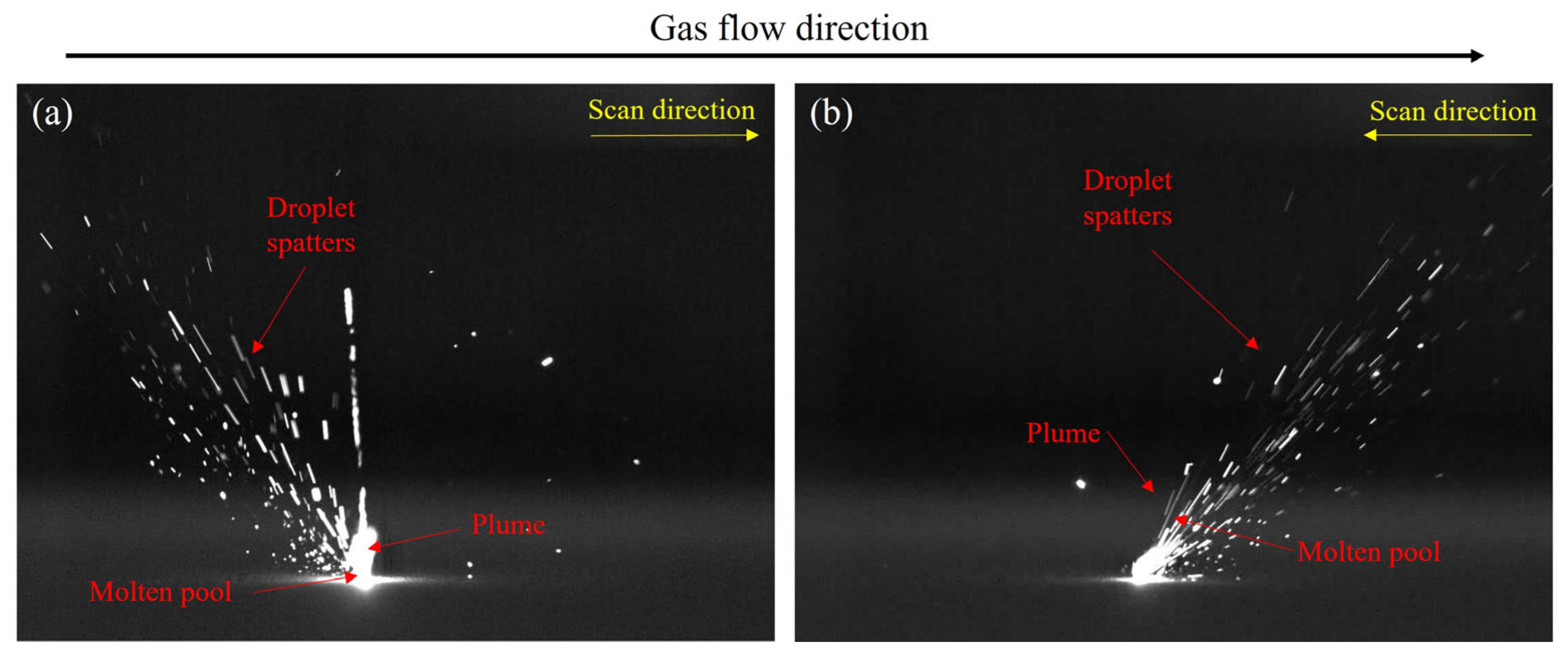
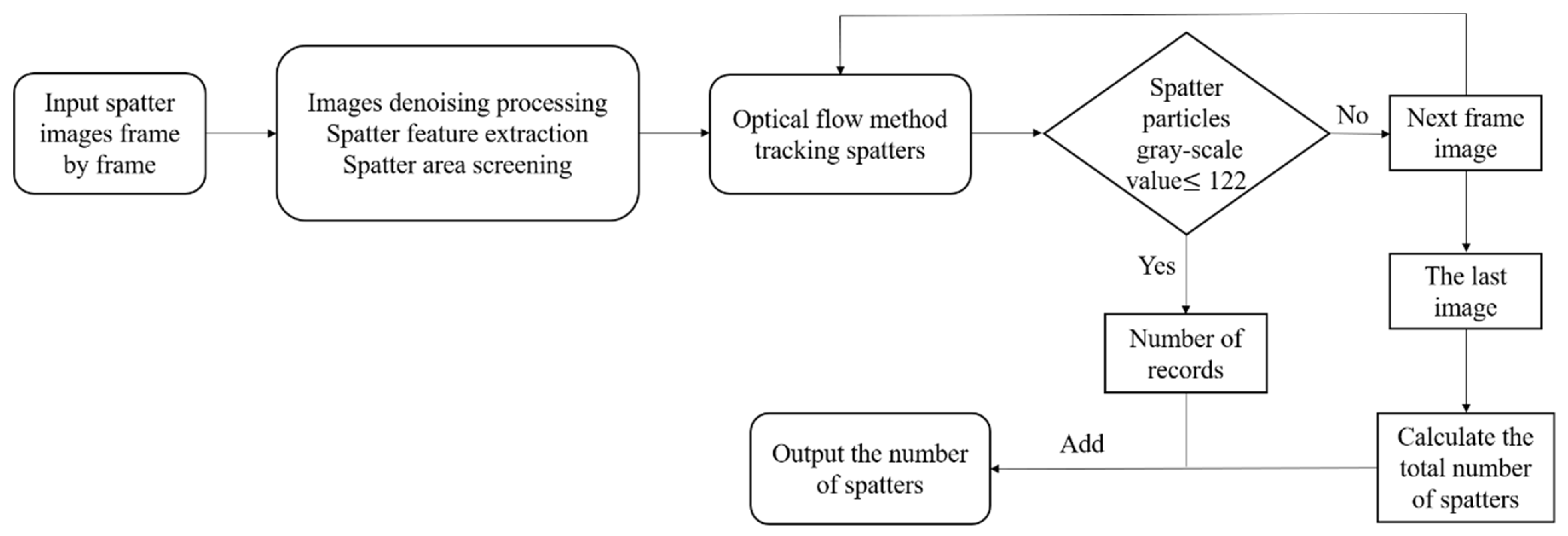

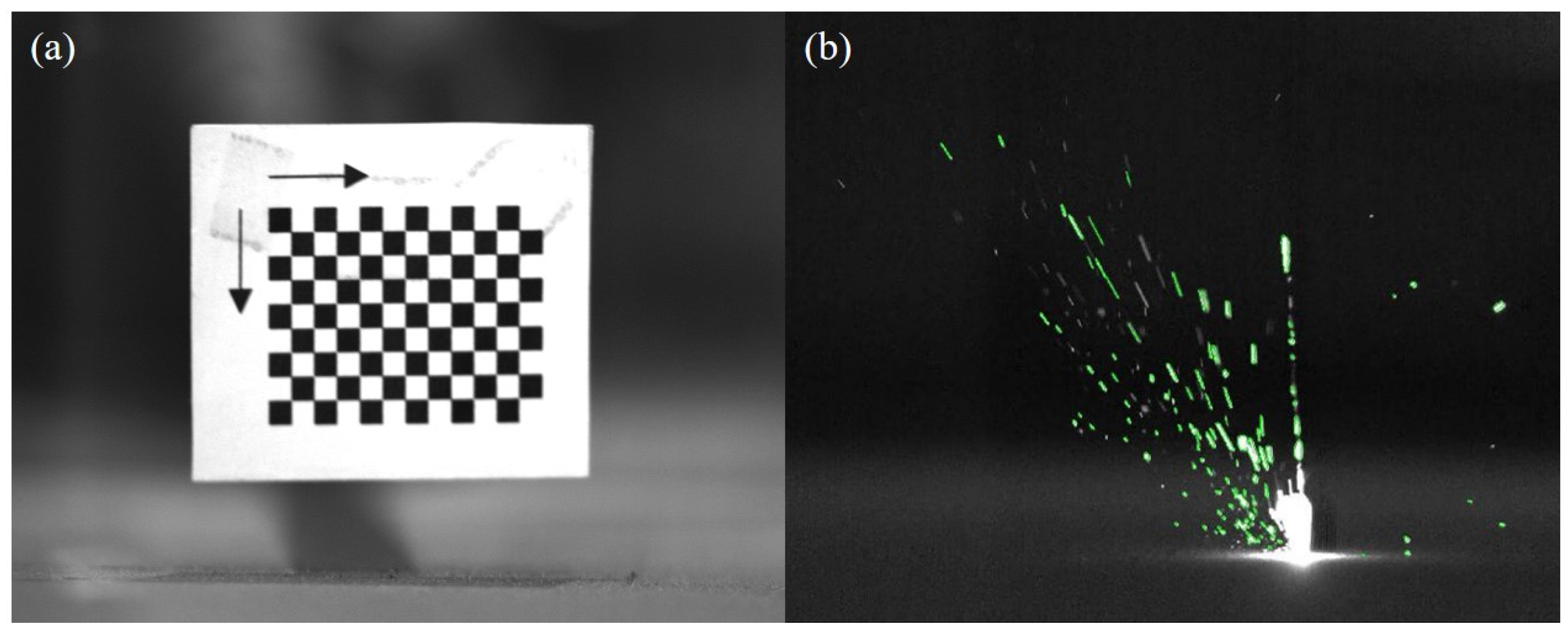

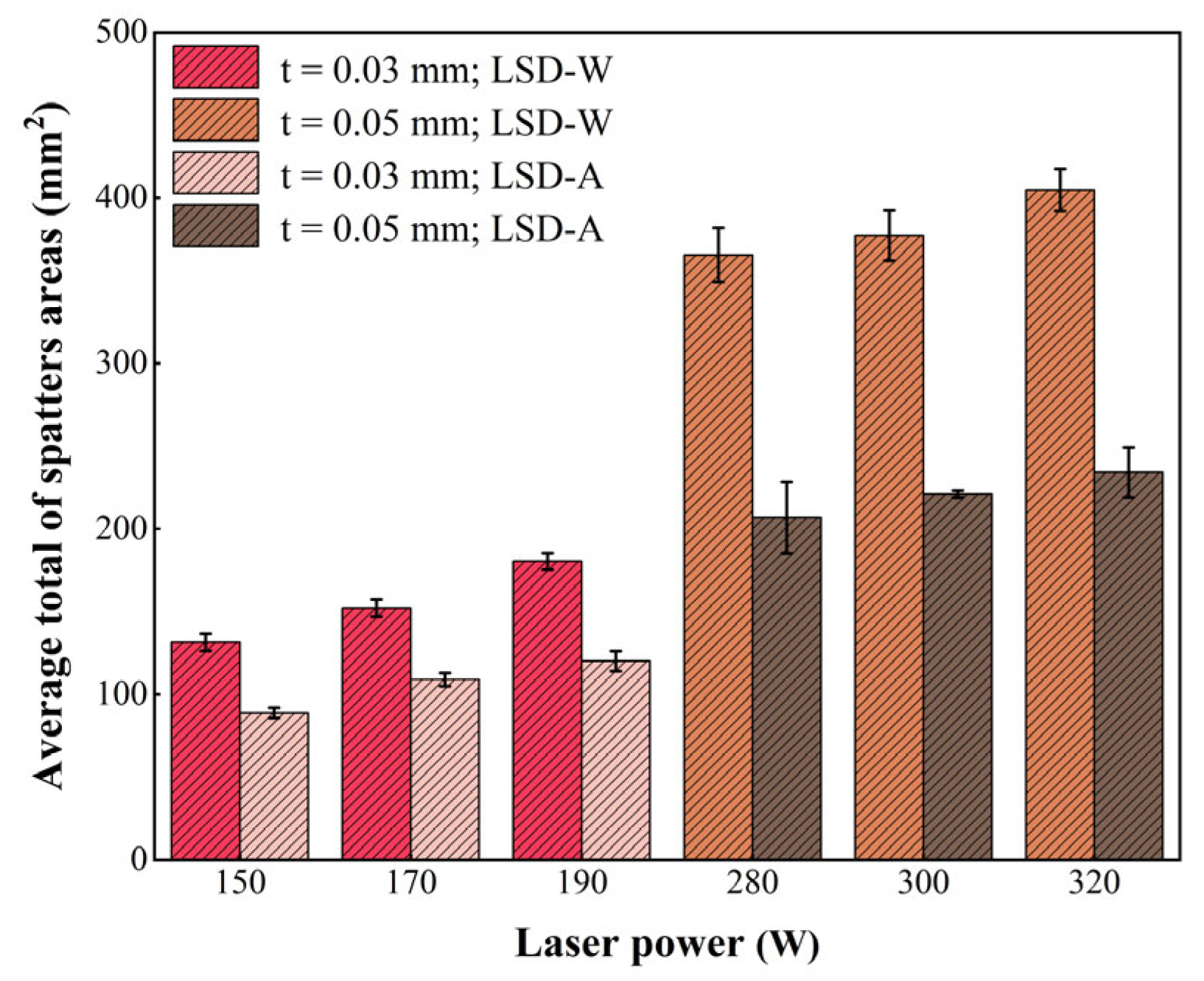
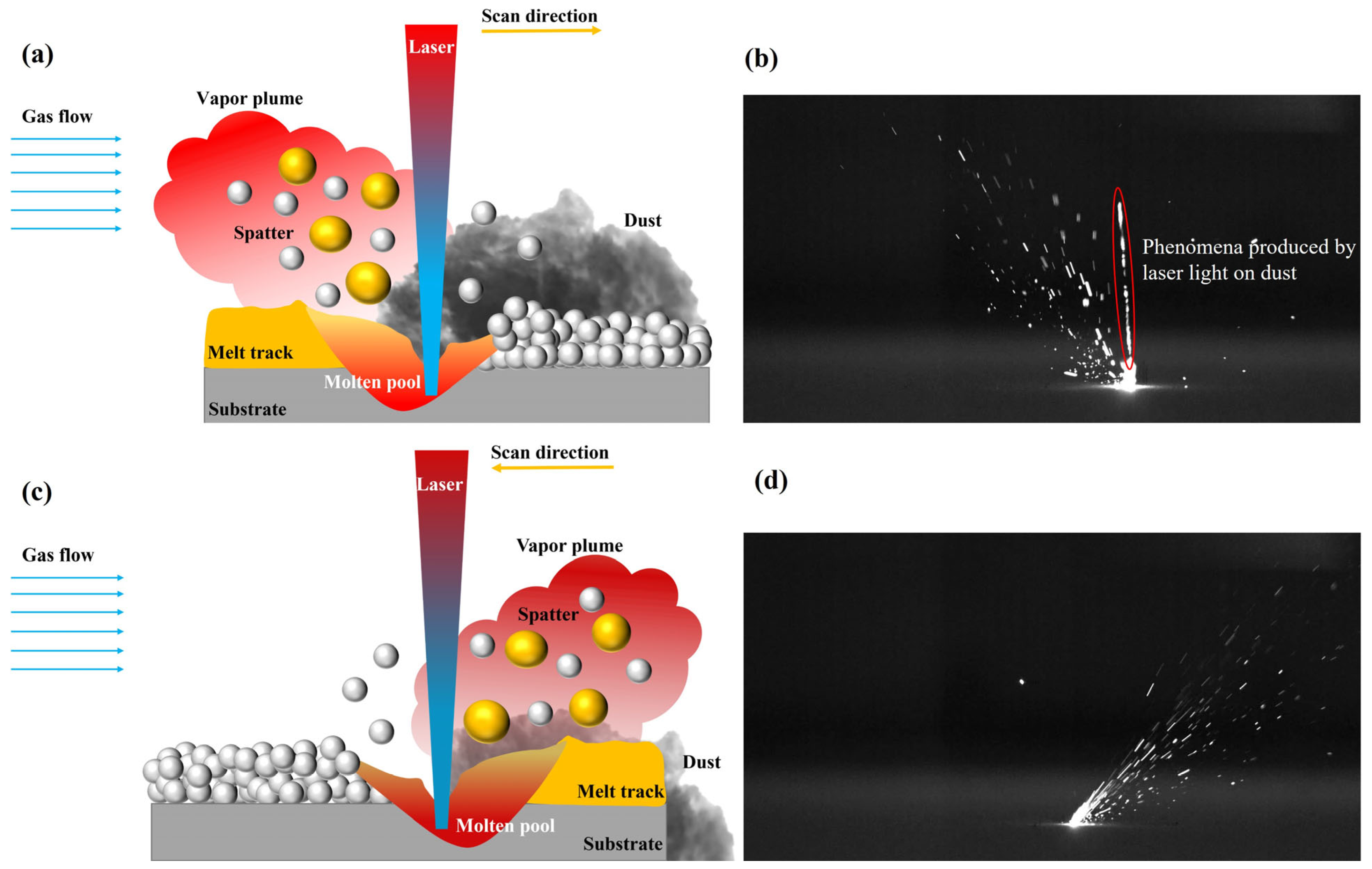

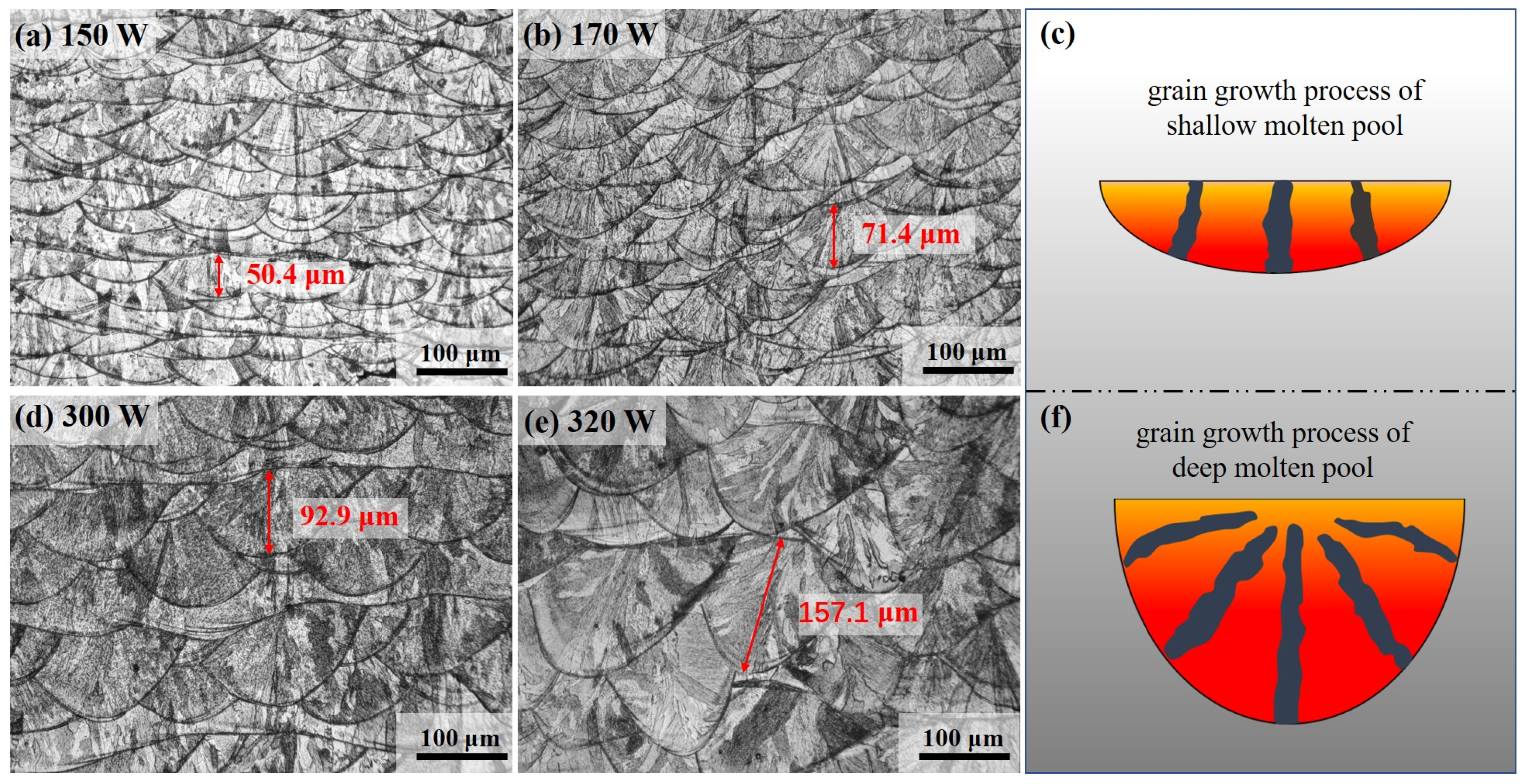
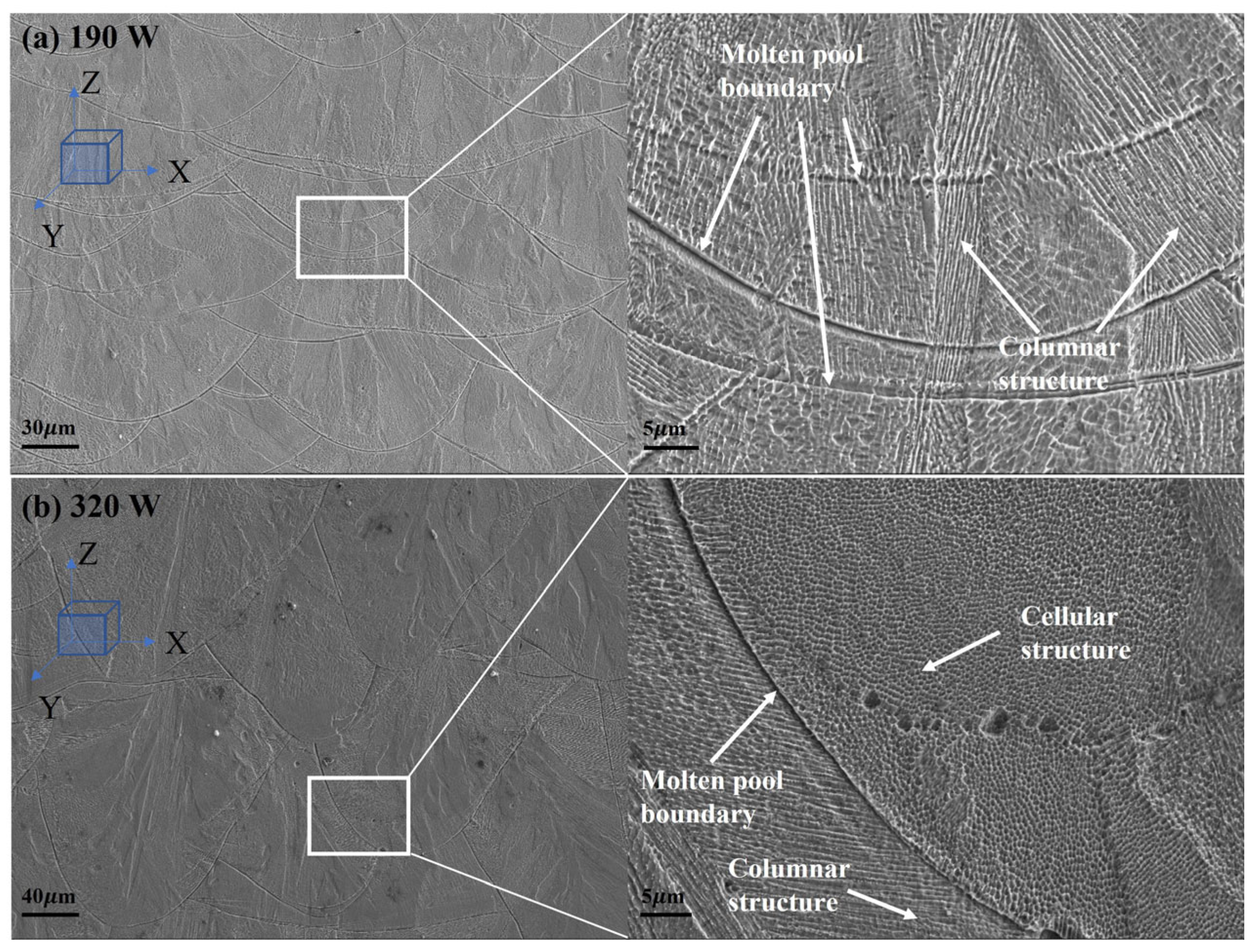
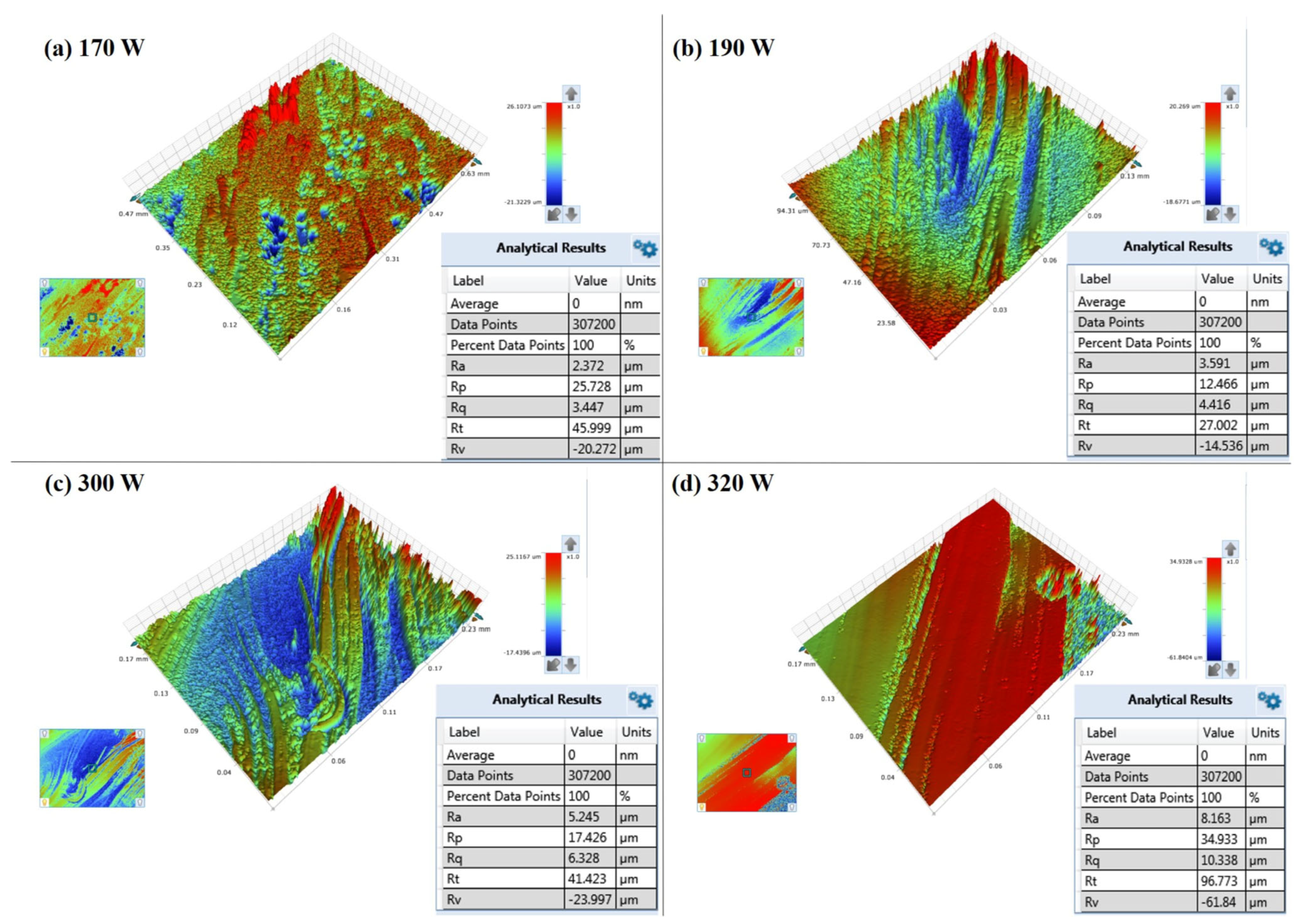
| Alloying Element | Fe | C | Si | Mn | Cr | Ni | Mo | P | S | O | N |
|---|---|---|---|---|---|---|---|---|---|---|---|
| Wt% | Balance | 0.03 | 1.0 | 2.0 | 16.0 | 12.0 | 2 | 0.02 | 0.02 | 0.08 | 0.1 |
| Group | Layer Thickness (mm) | Laser Power (W) | Scanning Speed (mm/s) | Gas Velocity (m/s) | Hatching Space (mm) |
|---|---|---|---|---|---|
| 1 | 0.03 | 150 | 1000 | 2.5 | 0.067 |
| 1 | 0.03 | 170 | |||
| 1 | 0.03 | 190 | |||
| 2 | 0.05 | 280 | |||
| 2 | 0.05 | 300 | |||
| 2 | 0.05 | 320 |
Disclaimer/Publisher’s Note: The statements, opinions and data contained in all publications are solely those of the individual author(s) and contributor(s) and not of MDPI and/or the editor(s). MDPI and/or the editor(s) disclaim responsibility for any injury to people or property resulting from any ideas, methods, instructions or products referred to in the content. |
© 2024 by the authors. Licensee MDPI, Basel, Switzerland. This article is an open access article distributed under the terms and conditions of the Creative Commons Attribution (CC BY) license (https://creativecommons.org/licenses/by/4.0/).
Share and Cite
Chen, X.; Song, J.; Zhang, W.; Shang, X.; Li, Y.; Chen, S.; Lin, J.; Zhou, Z. Effect of Spatter Behavior on Mechanical Properties and Surface Roughness of Printed Parts during PBF-LM of 316L. Materials 2024, 17, 860. https://doi.org/10.3390/ma17040860
Chen X, Song J, Zhang W, Shang X, Li Y, Chen S, Lin J, Zhou Z. Effect of Spatter Behavior on Mechanical Properties and Surface Roughness of Printed Parts during PBF-LM of 316L. Materials. 2024; 17(4):860. https://doi.org/10.3390/ma17040860
Chicago/Turabian StyleChen, Xiaoxuan, Jialei Song, Wei Zhang, Xin Shang, Yizhe Li, Shenggui Chen, Jiahao Lin, and Zirong Zhou. 2024. "Effect of Spatter Behavior on Mechanical Properties and Surface Roughness of Printed Parts during PBF-LM of 316L" Materials 17, no. 4: 860. https://doi.org/10.3390/ma17040860
APA StyleChen, X., Song, J., Zhang, W., Shang, X., Li, Y., Chen, S., Lin, J., & Zhou, Z. (2024). Effect of Spatter Behavior on Mechanical Properties and Surface Roughness of Printed Parts during PBF-LM of 316L. Materials, 17(4), 860. https://doi.org/10.3390/ma17040860






